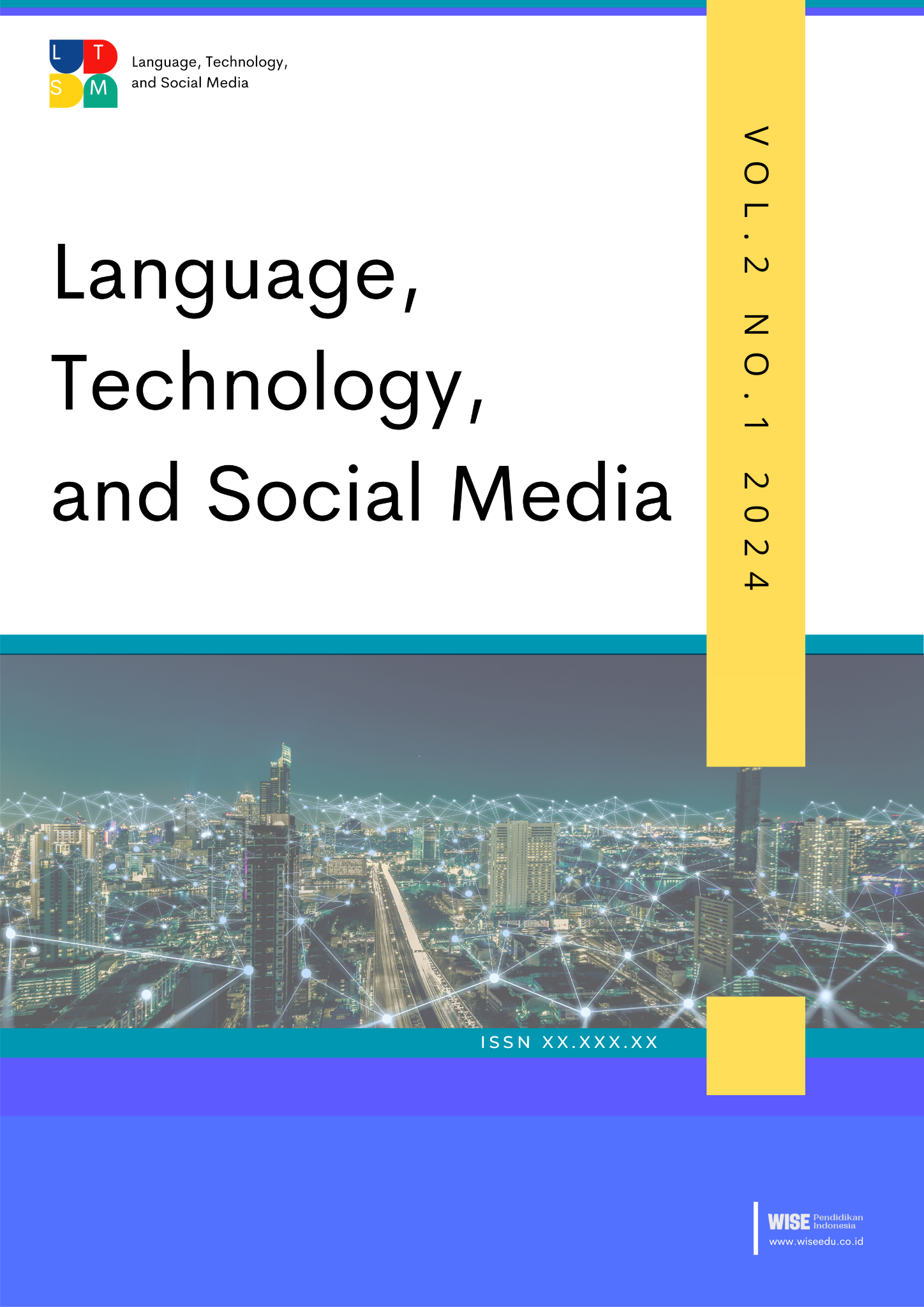Overcoming Challenges in Lampung Language Instruction: A Study on Teaching Methods and Educational Technology Integration
DOI:
https://doi.org/10.70211/ltsm.v2i1.40Keywords:
Lampung Language, Elementary Education, Cultural Preservation, Regional Language Teaching, Educational TechnologyAbstract
The Lampung language, a regional language rich in cultural and historical significance, has seen a significant decline in usage among younger generations, primarily due to the influences of globalization and the increasing dominance of national and international languages. This study aims to thoroughly identify and analyze the challenges faced in teaching the Lampung language at the elementary school level (SDN), focusing on SDN 1 Tanjungsari Lampung Selatan. Employing a qualitative approach with a case study method, this research investigates both internal factors, such as curriculum design and teaching methodologies, and external factors, including parental and community support. The findings reveal several key challenges: the limited availability of engaging teaching materials, inadequate teacher training, and low student interest in learning the Lampung language. To address these issues, the study suggests developing interactive digital teaching resources and enhancing teacher training programs to improve pedagogical competencies. Furthermore, integrating technology and incorporating local cultural elements into the teaching process can potentially boost student interest and engagement. This approach not only aligns with modern educational practices but also promotes a deeper appreciation of local heritage. Ultimately, this research aims to contribute to the preservation efforts of the Lampung language, ensuring its continued relevance and vitality as an integral part of Indonesia's rich cultural tapestry. Through strategic educational interventions, the study hopes to inspire greater interest and participation among the younger generation, thereby safeguarding the linguistic and cultural legacy of the Lampung people.
References
N. Lestari, Sudjarwo., and R. M. Sinaga, "Tendency of Lampung Language Users in Adolescents in Communicating: A Case Study in Lampung, Indonesia," Int. J. Res. Rev., vol. 10, no. 1, pp. 709-718, Feb. 2023. https://doi.org/10.52403/ijrr.20230180.
R. Maulana, Istiqomah, and Y. Mutmainnah, "Lampung Language in Bandar Lampung: Still Existing or Disappearing?," English Lang. Lit. Int. Conf., vol. 6, no. 1, pp. 86-93, 2024.
V. Septianingtias, Wahya, T. Nur, and F. Ariyani, "Lexical variation in the Lampung language, Indonesia," Cogent Arts Humanit., vol. 11, no. 1, Dec. 2024. https://doi.org/10.1080/23311983.2024.2309740.
E. S. Purwani, O. Sukmana, and V. Salviana, "The Threat of Extinction of Lampung Regional Language, Indonesia: A Phenomenological View," Int. J. Res. Eng. Sci. Manag., vol. 7, no. 5, pp. 90-96, 2024.
F. Ariyani, G. E. Putrawan, A. R. Riyanda, A. R. Idris, L. Misliani, and R. Perdana, "Technology and minority language: an Android-based dictionary development for the Lampung language maintenance in Indonesia," Tapuya Lat. Am. Sci. Technol. Soc., vol. 5, no. 1, Dec. 2022. https://doi.org/10.1080/25729861.2021.2015088.
Fadillah and H. Cholsy, "The Linguistic Landscape of The Eatery Names in The City of Bandar Lampung," no. Cisc. Atlantis Press SARL, 2023. https://doi.org/10.2991/978-2-38476-186-9_21.
S. Suhandano, "Javanese and the Samin Community: A reflection of ideology and identity of its speakers," J. Hum., vol. 32, no. 3, p. 283, 2020. https://doi.org/10.22146/jh.60213.
M. AlMarwani, "Academic Writing: Challenges and Potential Solutions," Arab World English J., vol. 6, no. 6, pp. 114-121, Jul. 2020. https://doi.org/10.24093/awej/call6.8.
L. S. Nurwahidah, "Preservation Of Language And Principles Of Local Culture Based Multicultural Education In Indonesia," J. Educ. Expert., vol. 2, no. 1, p. 33, Mar. 2019. https://doi.org/10.30740/jee.v2i1p33-38.
J. A. Fishman, "Language maintenance and language shift as a field of inquiry: A definition of the field and suggestions for its further development," Linguistics, vol. 51, no. s1, pp. 9-10, Aug. 2013. https://doi.org/10.1515/ling-2013-0038.
N. A. Alyami, "Readings in Language Shift Studies from the Past to the Present: Review Article," Int. J. Linguist. Lit. Transl., vol. 6, no. 6, pp. 21-41, May 2023. https://doi.org/10.32996/ijllt.2023.6.6.3.
H. Mahn and V. John‐Steiner, "Vygotsky and Sociocultural Approaches to Teaching and Learning," in Handbook of Psychology, Second Edition, Wiley, 2012. https://doi.org/10.1002/9781118133880.hop207006.
X. Mirvan, "The Advantages of Using Films to Enhance Student's Reading Skills in the EFL Classroom," J. Educ. Pract., vol. 4, no. 13, pp. 62-67, 2013.
E. Mutiara and E. Emilia, "Developing Flipbook-based Teaching-Learning Material in the Culinary Arts Program of Unimed," Int. J. Educ. Math. Sci. Technol., vol. 10, no. 3, pp. 650-662, May 2022. https://doi.org/10.46328/ijemst.2487.
K. Dwinalida and S. Setiaji, "Students' Motivation and English Learning Achievement in Senior High School Students," English Educ. Linguist. Lit. J., vol. 1, no. 1, pp. 1-9, 2022. [Online]. http://10.0.61.242/engtea.73.1.201803.135%0Ahttp://ezproxy.stir.ac.uk/login?url=http://search.ebscohost.com/login.aspx?direct=true&db=ehh&AN=129598345&site=ehost-live.
T. Susilowati et al., "Learning application of Lampung language based on multimedia software," Int. J. Eng. Technol., vol. 7, no. 2.27, p. 175, Aug. 2018. https://doi.org/10.14419/ijet.v7i2.27.9942.
M. N. I. Sarker, M. Wu, Q. Cao, G. M. Alam, and D. Li, "Leveraging Digital Technology for Better Learning and Education: A Systematic Literature Review," Int. J. Inf. Educ. Technol., vol. 9, no. 7, pp. 453-461, 2019. https://doi.org/10.18178/ijiet.2019.9.7.1246.
Riyanti et al., "Internet-based learning in improving student digital literacy," Cendikia Media J. Ilm. Pendidik., vol. 13, no. 4, pp. 585-594, 2023.
Z. Arifin, S. R. Febriani, H. Y. Saputra, and A. Anasruddin, "Arabic Learning in The Digital Era: Approach in Online System," Lughawiyah J. Arab. Educ. Linguist., vol. 3, no. 1, p. 73, Jun. 2021. https://doi.org/10.31958/lughawiyah.v3i1.2752.
M. Crnjac, I. Veža, and N. Banduka, "From concept to the introduction of industry 4.0," Int. J. Ind. Eng. Manag., vol. 8, no. 1, pp. 21-30, 2017. https://doi.org/10.24867/IJIEM-2017-1-103.
Sugiyono, Metode Penelitian Kuantitatif, Kualitatif, dan R&D, Bandung: CV Alfabeta, 2019.
Khamparia and B. Pandey, "Impact of Interactive Multimedia in E-Learning Technologies," 2017, pp. 171-199. https://doi.org/10.4018/978-1-5225-2489-2.ch007.
K. Utami, M. Akhyar, and S. Sudiyanto, "Potential Implementation of Android-Based Interactive Multimedia for Student Learning Activities," AL-ISHLAH J. Pendidik., vol. 15, no. 1, pp. 507-518, 2023. https://doi.org/10.35445/alishlah.v15i1.2641.
M. D. Abdulrahaman et al., "Multimedia tools in the teaching and learning processes: A systematic review," Heliyon, vol. 6, no. 11, p. e05312, Nov. 2020. https://doi.org/10.1016/j.heliyon.2020.e05312.
N. O. Argawati and L. Suryani, "Digital-based instruction: Chances and challenges in English language teaching context," Int. J. Eval. Res. Educ., vol. 9, no. 4, p. 1138, Dec. 2020. https://doi.org/10.11591/ijere.v9i4.20579.
M. R. Salaberry, "The Use of Technology for Second Language Learning and Teaching: A Retrospective," Mod. Lang. J., vol. 85, no. 1, pp. 39-56, Mar. 2001. https://doi.org/10.1111/0026-7902.00096.
J. M. Fernández-Batanero, M. Montenegro-Rueda, J. Fernández-Cerero, and I. García-Martínez, "Digital competences for teacher professional development. Systematic review," Eur. J. Teach. Educ., vol. 45, no. 4, pp. 513-531, Aug. 2022. https://doi.org/10.1080/02619768.2020.1827389.
P. D. Ekantiningsih and D. Sukirman, "Trends of education and training teacher competency in information and communication technology," J. Inov. Teknol. Pendidik., vol. 10, no. 1, pp. 87-105, 2023. https://doi.org/10.21831/jitp.v10i1.52630.
Cirocki and T. S. C. Farrell, "Professional development of secondary school EFL teachers: Voices from Indonesia," System, vol. 85, p. 102111, Oct. 2019. https://doi.org/10.1016/j.system.2019.102111.
Badrun Kholid, Arif Rahman, and Lalu Ari Irawan, "Implementing Diagnostic Assessment in Designing Differentiated Learning for English Language Learning at the Junior High Schools," J. Lang. Lit. Stud., vol. 4, no. 2, pp. 445-458, 2024. https://doi.org/10.36312/jolls.v4i2.1934.
F. Thresia, "Integrating Local Culture To Promote Character Education In Teaching Writing," Premise Journal, vol. 4, no. 2, Oct. 2015. https://doi.org/10.24127/pj.v4i2.303.
H. Herdi, Ribut Wahyu Eriyanti, and Atok Miftakhul Huda, "Teacher's Strategies in the Classroom Setting: Integrating Local Culture into English Language Teaching," ELT-Lectura, vol. 10, no. 2, pp. 105-114, Aug. 2023. https://doi.org/10.31849/elt-lectura.v10i2.15092.
Y. Romrome and O. T. Ena, "Incorporating Local Culture in English Language Teaching for Papuan Junior High School Students," J. English Educ. Teach., vol. 6, no. 2, pp. 207-221, Jun. 2022. https://doi.org/10.33369/jeet.6.2.207-221.
L. Emiliya Hidayat and M. Dzulfiqar Praseno, "Improving Students' Writing Participation and Achievement in an Edpuzzle-Assisted Flipped Classroom," Educ. English as Foreign Lang., vol. 4, no. 1, pp. 1-8, Jan. 2021. https://doi.org/10.21776/ub.educafl.2021.004.01.01.
V. Manipatruni and S. K. Nannapaneni, "The role of Ed puzzle in online English language teaching and learning-a revolution through gamification during COVID-19 pandemic," Int. J. Aquat. Sci., vol. 12, no. 2, pp. 1221-1226, 2021. [Online]. http://www.journal-aquaticscience.com/article_132058_891efcf3d4341216401af5bf63074d34.pdf.
L. Zhu and S. M. Atompag, "The Application of the Constructivism Theory in Enhancing Classroom Teaching," J. Contemp. Educ. Res., vol. 7, no. 12, pp. 209-213, Dec. 2023. https://doi.org/10.26689/jcer.v7i12.5792.
D. Kim, "Learning Language, Learning Culture: Teaching Language to the Whole Student," ECNU Rev. Educ., vol. 3, no. 3, pp. 519-541, Sep. 2020. https://doi.org/10.1177/2096531120936693.
R. M K Nambiar, R. S. Hashim, and R. Mohammad Yasin, "Impact of Integrating Local Culture Into Language Materials on Communicative Ability of Malaysian Lower Secondary Learners," 3L Southeast Asian J. English Lang. Stud., vol. 24, no. 4, pp. 13-26, Dec. 2018. https://doi.org/10.17576/3L-2018-2404-02.
L. Septiyana, A. Aneka, B. Mandasari, and F. S. S. Ramadhan, "Development of A Trilingual E-Dictionary for Early Childhood; Indonesia-English-Lampung," Tapis J. Penelit. Ilm., vol. 7, no. 2, p. 160, Sep. 2023. https://doi.org/10.32332/tapis.v7i2.7817.
Z. Dörnyei and C. Muir, "Creating a motivating classroom environment," 2019, pp. 1-18. https://doi.org/10.1007/978-3-319-58542-0_36-1.
K. Kudsiyah, L. Mauludiyah, and M. Murdiono, "Arabic Video Lyric Untuk Meningkatkan Pemahaman Kosakata Bahasa Arab Siswa," Ta'lim al-'Arabiyyah J. Pendidik. Bhs. Arab Kebahasaaraban, vol. 5, no. 1, pp. 52-60, 2021. https://doi.org/10.15575/jpba.v5i1.11351.
Downloads
Published
How to Cite
Issue
Section
License
Copyright (c) 2024 Ridho Rachman, Eka Putri Zulfatussoraya

This work is licensed under a Creative Commons Attribution 4.0 International License.
This article is an open access article distributed under the terms and conditions of the Creative Commons Attribution-ShareAlike (CC BY 4.0) license (https://creativecommons.org/licenses/by/4.0/).
.gif)
.png)









